Facts about the NNC
.
Requirements for Joining
.
An applicant for the Navy Nurse Corps had
to meet the following requirements:
.
| * |
Minimum preliminary education: High-school
graduate |
| * |
Registered Nurse; graduate from a school of
nursing approved by the Surgeon General |
| * |
Age 22 to 28 |
| * |
Citizen of the United States or naturalized
citizen for 10 years |
| * |
Single, widowed, or legally separated |
| * |
Physically qualified |
| * |
Satisfactory credentials from training schools
and other sources |
.
.
Nurses could also apply to the Naval Reserve
Nurse Corps. Reserve Corps nurses were only appointed for duty with the
Navy in time of war or National emergency for such time as their services
are required. They received the same pay, allowance, and privileges as
the Regular Corps. Permitted age for joining the Reserve was between 21
and 40 years. The membership of the Red Cross Nursing Service was acceptable
in lieu of the usually requested credentials. Reserve Nurses were allowed
to transfer to the Regular Corps if they met the requirements.
.
.
Regular Navy Nurses and Reserve Corps Nurses
were appointed by the Surgeon General with the approval of the Secretary
of the Navy. Nurses of the Regular Corps began with a 3-year appointment.
.
 Physical examination of a Navy
Nurse Corps applicant
Physical examination of a Navy
Nurse Corps applicant
|
.. |
The physical qualifications were set high.
Some common causes for rejection were: defective vision below 12/20 in
each eye unaided by glasses, defective hearing, deformity of disabling
character, constitutional disease, acute or chronic skin disease, enlarged
or chronically diseased tonsils, loss of teeth or non vital teeth, diseased
condition of lungs or chest, diseased heart, blood pressure above or below
normal, disease of kidneys, disease of the abdominal or pelvic viscera,
abnormal mental or nervous disturbances. |
.
| The following table shows the required height
and weight. Height had to be taken without shoes and 5 pounds were deducted
for clothing. |
.

1
A variation of 15 pounds may be made in certain cases.
.
Navy nurses could be discharged
for the following reasons:
.
1. Violation of ethics
2. Not adaptable to Navy Service
3. Lack of physical endurance
4. Excessive sick days for minor complaints
5. For the good of the service
.
In fact, most resignations were requested
due to marriage. |
.
Types of Duty
.
Probationary Period
.
Every Navy Nurse and Naval Reserve Nurse served
a 6 months probationary period for observation of her adaptability, endurance,
and professional qualifications for the Navy service. Afterwards, she was
recommended for acceptance or rejection by the commanding officer of the
station to which she was assigned.
.
During the probationary period, the nurses
had to take classes in Navy protocol, Navy policy and procedure. Additionally,
they had classes in marching, drilling and swimming. If desired, there
was the opportunity to take special courses. |
.... |
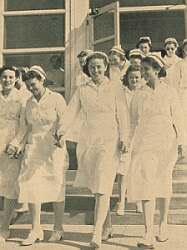 Navy Nurses going on duty
Navy Nurses going on duty
|
.

This lieutenant commander inspects
his baby in the dependency ward of the hospital at the Naval Air Station
in Alameda, California.
|
., |
The duty of Navy Nurses was to provide adequate
nurse care for the Navy, Marine Corps and Coast Guard personnel. This included
the members of the Women’s Reserves. Additionally, they cared for dependents
where facilities were available for their hospitalization. |
.
Nurses had the opportunity to
administer medical tasks within the specialties of their profession such
as anesthesia, dietetics, physical therapy or executive duties.
.
Teaching hospital corpsmen was one of the
most important duties of Navy Nurses. They were responsible to make these
men capable of conducting nurse duties aboard combat ships and in other
positions where Navy Nurses were not allowed to serve. Since March 1943,
Navy Nurses also trained WAVES (Women's Reserve of the US Naval Reserve)
for hospital duty inside continental USA.
During peace times, Navy Nurses at overseas
stations had helped to establish hospitals and trained native women, but
this service mostly was suspended for the duration of the war.
.
Under special circumstances, Navy Nurses were
assigned with temporary additional duty orders (TAD). For example, they
helped to evacuate women and children who were Navy dependants on transport
ships from endangered places.
Promotion was considered for nurses who demonstrated
unusual ability for the service, and adaptability. Such nurses were selected
upon the recommendation of the commanding officer of the station to which
they were assigned. |
.. |

Navy Nurse teaching hospital corpsmen
in a classroom
.
.
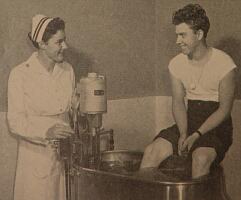
Administering physical therapy
|
.
Most general assignments of
Navy Nurse were:
| - |
Ward supervision and administration |
| - |
Out-patient dispensary work |
| - |
Industrial clinics in connection with naval
construction |
| - |
Naval air base or Marine Corps air base dispensaries |
| - |
Transport service |
| - |
Hospital ships |
| - |
Operating room supervision |
| - |
Anesthetists |
| - |
Naval training station hospitals |
| - |
Foreign duty |
| - |
Hospital Corps Training Schools as instructors |
| - |
Pediatric clinics |
| - |
Physical Therapy |
| - |
Convalescent hospitals |
| - |
Dietetics |
| - |
Officer Procurement Offices |
| - |
Family hospitals |
| - |
First aid stations |
| - |
Ammunition depots and dispensaries |
|
Hospital Ships
.
| The service on Navy Hospital ships was an
important and high ranking assignment for Navy Nurses. At the outbreak
of war, the Navy had two hospital ships, the USS Relief and the
USS Solace. A total of 12 Nurses were serving abroad the USS Relief
and 13 nurses abroad the USS Solace. During the war, the number
of hospital ships was increased to fifteen.
(Three of these fifteen hospital ships (the USS
Comfort,
USS Hope and USS Mercy) were manned by Navy crews but staffed
with Army medical and surgical personnel.) |
... |
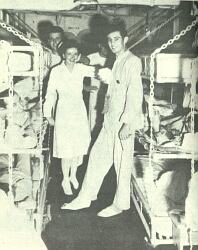 Ward on the hospital ship USS
Relief
Ward on the hospital ship USS
Relief
|
.
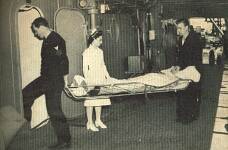 Navy Nurse on a hospital ship
superintendents the bringing aboard of a patient.
Navy Nurse on a hospital ship
superintendents the bringing aboard of a patient.
|
.. |
During 1942 and 1943 the urgent need for more
hospital ships became apparent. While the nurses were trained, the hospital
ships were being converted from other ships on hand.
The USS Bountiful, USS Refuge
and USS Samaritan were converted from transport ships into hospital
ships during 1944 because of the increasing number of casualties on an
emergency basis. These added hospital ships were not enough to handle the
tremendous casualties from the many island invasions and naval battles
that took place in 1944. |
.
By 1945, the Navy was desperate for sufficient
hospital ships. The USS Rescue was converted from a seaplane tender
in 1945 because the need for treating casualties in the Pacific battles
became much greater than the need to maintain seaplanes. Finally, late
in the war, the USS Haven, USS Benevolence, USS Tranquillity,
USS Consolation, USS Repose and USS Sanctuary were
converted from C4-S-B2 type cargo ships into hospital ships of a consistent
design for modern fleet operations (known as the “Haven” class).
Unfortunately, they did not join the fleet until 1945, which was the last
year of fighting for America in World War II.
.
| They functioned as hospitals and medical supply
ships, servicing advanced base hospitals and warships. While former hospital
ships had space for about 450-750 patients, the “Haven” class provided
places for 802 patients (742 enlisted, 60 officers), a number that could
be increased to over a thousand in an emergency. The nurse’s quarters had
accommodation for thirty nurses. |
.. |
 Hospital ship ward
Hospital ship ward
|
.
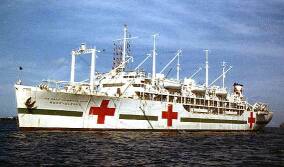 Navy Hospital Ship USS Benevolence
Navy Hospital Ship USS Benevolence
|
.. |
After the Hague Convention of 1907, the hospital
ships were always white with a wide green band painted around the hull
and large Red Crosses for easy identification. They were fully lighted
at night.
|
.
| On board the nurses had double duty as nurses
and administrators. Most patients had to be treated because of burn cases
(from ship hits), combat wounds or malaria (in Pacific areas). The nurses
lived under frequent alerts. Life-vests and gas masks were constant companions. |
.. |
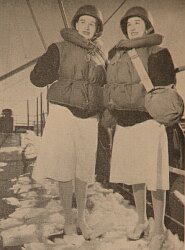
Navy Nurses in life jackets aboard
a hospital ship in the North Atlantic Ocean.
|
.
After the end of war, a special duty of
some hospital ships was to collect and process Allied prisoners of war.
In the South Pacific, first POWs already were taken aboard in September
1945.
..
Flight Nurses
.
Later in the war, a new work field for Navy Nurses
was opened: air evacuation. This was considered an exceptionally elite
position, and allowed only the finest nurses. Soon this assignment ranked
even higher than duty in Pearl Harbor or on a hospital ship, which had
always demanded the best nurses.
.
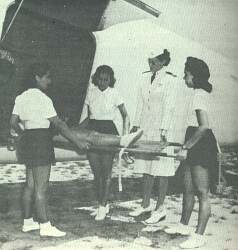
One of the two flight nurses who
helped to establish a Brazilian Flight Nurse school with several members
of the first training class. |
.. |
The first two Navy nurses started their training
as flight nurses in December 1943. They were sent to the Army Air Force
School of Air Evacuation at Bowman Field, Kentucky, since the Navy had
not established its own flight school yet. The two nurses were assigned
to assist in setting up air evacuation training for the Brazilian Air Force
nurses after finishing their course. Evacuation by air was very valuable
for Brazil in peacetime as well, because only planes could reach patients
in inaccessible jungle and mountain regions.
The two nurses arrived in Rio de Janeiro on
30 January 1944. These two nurses not only provided pioneer work in teaching
the students in Brazil their knowledge as flight nurses, but also pioneered
in establishing and popularizing a modern nursing school there. Both received
the Navy Commendation Ribbon for their service in Brazil. |
.
At the end of 1944, the Navy set up its own
school of air evacuation at the Naval Air Station (NAS) in Alameda, California.
The first course for flight nurses opened on 11 December 1944. Out of an
overwhelming number of applications, 24 Navy Nurses were selected to take
part in the training. Flight surgeons, widely considered as among the most
highly-qualified medical doctors available, were the course instructors.
The course lasted 2 months and included training films, lectures on aeronautical
medicine and advanced medical demonstrations.
.
| The nurses learned how to handle patients
in case it would be necessary to ditch the plane and how to manage life
rafts and immersion suits. They were put through decompression chambers
to get to know how oxygen deprivation feels by actual experience. They
were taught how to load and unload litter patients. They had to practice
survival drills. Since most of the air evacuation was over water, every
flight nurse had to be a very good swimmer. For example, flight nurses
had to be able to swim a mile, tow or push a victim for 220 yards, race
through the water for 440 yards in ten minutes and swim under water (to
escape burning oil). |
.. |
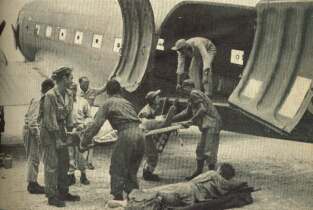 .
.
A flight nurse helps load litter
patients into an evacuation plane.
|
.
All applicants had to pass the AAA tests which
were required for pilots. Due to these high requirements and the limited
number of admissions not more than a fifth of the nurses who volunteered
were accepted for flight nurse training.
The task of air evacuation was assigned to
the Naval Air Transport Service (NATS). The 24 flight nurses of the first
class, 24 corpsmen and a flight surgeon were to staff the first 12-plane
air evacuation squadron VRE-1. They started their active flying service
directly after the first training course was completed. In March 1945,
the first Navy flight nurse to set foot on a battlefield helped to evacuate
wounded Marines from Iwo Jima while the battle for the island was still
in progress. By the middle of March, nearly a hundred flight nurses were
serving.
.
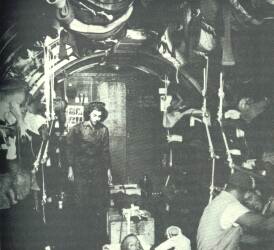
A member of the first class of
Navy Flight Nurses in charge of patients from Okinawa in one of the big,
four-engine Naval Air Transport planes.
|
.. |
The air evacuation program was a big success.
The most massive air evacuation of patients from a battle zone during Word
War II was undertaken during the Okinawa Campaign that started on April
1945 and ended in June. In six weeks the NATS VRE-1 squadron evacuated
9,600 casualties despite extremely bad weather conditions, constant hostile
fire from enemy positions, poor airfield conditions and extremely long
and very dangerous flight paths. |
.
| The hospital planes carried patients with
head wounds, extensive burns, fractures, amputations, malaria and combat
fatigue. Among other things, the flight nurses prepared and served food,
administered medicines, gave blood plasma and changed dressings during
the flight. |
.. |
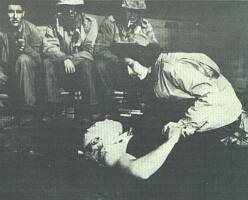 Flight nurse caring for a wounded
soldier
Flight nurse caring for a wounded
soldier
|
.
.
[ I. Development ]
[ II. Facts about the NNC ] [ III. Uniforms
] [ IV. Sources
]
|

